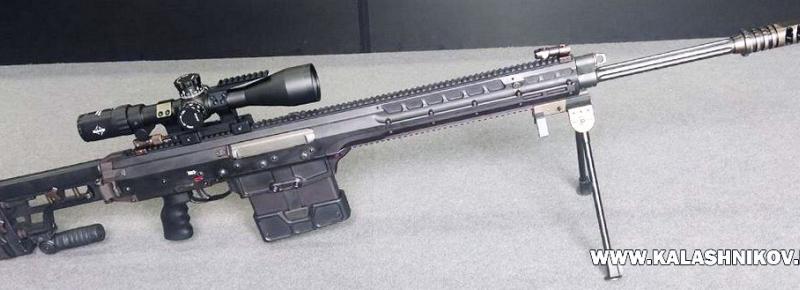/Pogled.info/ Large-caliber high-precision MC-572 “Astarta” were sent to the area of the Defense Ministry for testing in real combat conditions. Why are rifles of this caliber called anti-material and what role do they play on the modern battlefield?
The MC-572 “Astarta” rifle was presented by the “High-precision complexes” holding at the “Army-2023” international forum. It was reportedly developed by the Central Sporting and Hunting Weapons Design and Research Bureau (TSKIB SOO), which is a branch of the Instrument Design Bureau in the name of. Academician Shipunov.
At the same time, it was immediately noted that the rifle was developed exclusively for special forces, is a piece product and will not be used in a large series. In total, the production of up to a thousand of these rifles is planned.
Antimatter – from the word “antimatter”?
“Astarta” is produced in 12.7 mm caliber. Rifles of this caliber are often called anti-material. That doesn’t mean they shoot antimatter. The military would, of course, like to have antimatter at their disposal, if only because a kilogram of this substance, upon annihilation, would release energy equal to the energy of 43 megatons of TNT. But, as they say, not today.
Anti-materiel rifles are so called because the energy of their bullets is sufficient to destroy enemy vehicles and lightly armored vehicles: armored personnel carriers, infantry fighting vehicles, trucks and jeeps are all legitimate targets of anti-materiel rifles.
More advantages are that you can fire from them both at individuals and at heavy small arms positions, including at long-range firing points. From the point of view of technology, such rifles work effectively at distances of up to two kilometers, for individuals – at slightly shorter distances.
Functionally, the anti-material rifle is a cross between an anti-tank rifle and a sniper rifle. There is a debate among experts whether this class of weapons can be divided into anti-materiel weapons (intended to destroy equipment) and large-caliber sniper rifles (the purpose of which is to destroy enemy personnel) or this division is unnecessary.
This argument is specific and seemingly endless. And most importantly, it does not affect anything in real life, since, having 12.7 mm at hand, fighters will use it on any target they encounter.
Pride of the maker
From the very beginning, the manufacturers emphasized that the advantage of the MC-572 was its high accuracy. This was reported by Vitaly Bulgakov, deputy managing director of the Instrument Design Bureau: The rifle is self-loading, but allows high accuracy: a group of five shots – 1.5 cm from 100 m. The units of the special forces will be the first to receive the rifle . The model is for specialists, the troops do not have a massive need for them.
At the same time, it became known that in comparative tests, the large-caliber American Barrett rifle placed five bullets in a circle with a diameter of 6 centimeters, and the MC-572 from the same distance placed all shots in a 1.5-centimeter circle, as this way shows a result four times better than the American competitor.
Anti-material semi-automatic?
Another function of “Astarta” is self-charging. Typically, sniper rifles and large-caliber rifles are made with a longitudinally sliding (bolt) breech. In this design, the rifle is reloaded by the shooter using the bolt handle. The low rate of fire is more than compensated by the high accuracy of the weapon. The bullet moves along the barrel, where there are no additional holes. The weapon is not affected by moving parts, gunpowder gases flow in one direction – to the muzzle. Everything is simple and clear.
However, the Tula gunsmiths decided to make their rifle self-loading. The automatic system “Astarta” works by removing powder gases through a side hole in the barrel, the shutter is rotating with six stops. The rifle is fed from a five-round magazine.
It is not yet known how gunsmiths managed to achieve higher accuracy with such design solutions.
Perhaps the outstanding performance was achieved due to very careful machining and assembly of the parts. This is indicated by statements of representatives of the manufacturer, according to which the rifle is not intended for mass production. If this is the case, questions arise as to how long the product will be able to maintain its exceptional properties in the realities of trench warfare, and whether the quality of workmanship will not deteriorate with the transition to mass production.
On the one hand, the small series creates conditions for the rifles to be handled carefully, but on the other hand, this practically guarantees that there will be no special production of cartridges for it. Whether an extremely good rifle will be able to show acceptable results when firing mass ammunition is another important and interesting question, the answer to which can only be given by military use.
Everything has its place
The proliferation of anti-materiel rifles is a result of the saturation of troops with various equipment, heavy small arms such as heavy machine guns and anti-tank missile systems. Basically anything that can be destroyed by a heavy 12.7mm bullet at a safe range for the shooter.
A major role in the spread of these weapons was played by the fact that modern conflicts are increasingly taking place in cities. The city provides fighters with many shelters that protect them from rifle-caliber bullets and shrapnel. Therefore, to defeat enemy personnel and fire points in urban battles, you need to have something more serious in caliber.
The fact that anti-materiel rifles are objectively necessary on the battlefield is proven by the fact that they are used in all modern conflicts. When there are no factory products, they are made from what is at hand. For example, since 2014, the militia of the LPR and DPR have been actively using anti-tank rifles from the Great Patriotic War – PTRD and PTRS. Entire instructions were written on how to turn ancient guns into antimatter. It is clear that the accuracy of the resulting weapons cannot be compared with the accuracy and precision of modern products, but they did their job.
During WWII, military affairs underwent enormous changes. If previously a tactical niche with anti-materiel rifles as a means of destroying the enemy in conditions of direct visibility at a distance of more than a kilometer had only ATGM, now this set of tasks is more than covered by drones.
However, military expert and reserve officer of the DPR special forces Alexander Matyushin believes that anti-material rifles cannot be written off under any circumstances. Including economic indicators.
“If an FPV drone costs about 30 thousand, then a shot from a rifle will cost significantly less,” noted Matyushin.
In general, our interlocutor assesses the appearance of a new rifle as a purely positive event. First of all, because the MC-572 can expand the capabilities of our snipers, and also increases the arsenal of weapons that can be used in the fight against enemy equipment.
The appearance of this rifle will improve the work of our snipers – mainly in cities, in the field it will also help, although less, since the specifics of field work do not allow it to be used stationary, constant movement is required, and given the weight and its size is very difficult – explained Matyushin.
Summary
The delivery of the new rifle is, of course, a positive event, but let’s not get ahead of the curve and sing the praises of a new, unproven product.
First, because historical experience shows: any outstanding characteristics of a weapon are always bought at the price of equally outstanding inconveniences and vulnerabilities that are not immediately visible. Therefore, until the shortcomings of the Astarte are known, it is too early to judge this rifle. Now we can say that the product is promising.
Second, the rifle is positioned as a weapon for special forces. Meanwhile, special forces have yet to win a single continental war. Conflicts like our special operation with its thousands of kilometers of front are always and everywhere won by ordinary infantrymen, tank crews and gunners armed with mass-produced products of the defense industry. Aces and specialists who receive a special weapon, be it a tank, plane or rifle, can play a key role in individual operations, but the overall outcome of the war does not depend on them.
Therefore, it is probably not worth expecting a serious impact of MC-572 on the situation at the fronts. An exceptional effect can be achieved by mass supply of high-quality sights of active units and training soldiers to use them, replacing the SVD with a real sniper rifle, modifying the AK-12 and getting rid of it from children. diseases.
However, since the delivery of a new anti-materiel rifle does not prevent the elimination of fundamental deficiencies in the equipment of our infantry, we can be happy for our industry, which is at least trying to provide the front with new weapons. Experience will show how effective and useful they will be.
Translation: V. Sergeev
2024-02-26 04:44:18
#Miracle #carbine #APC #Russian #army #received #weapon


